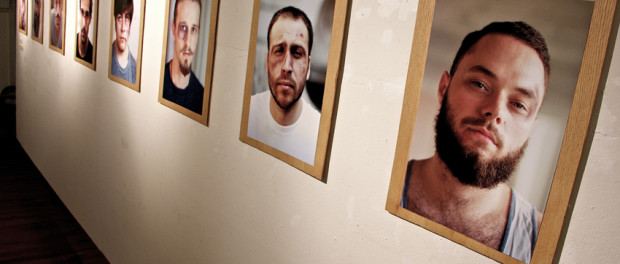Silence is Not Golden. Kim Johnson’s À Jamais Makes Emotional Pain Visible
An all too brief one-day art exhibit of Kim Johnson’s work looked at the brutality of pain from love. Kim Johnson collaborated with a make-up artist to showcase a series of works — photographs and line drawings — that captured emotions that need to be brought to the surface. She talked to me about the meaning of the exhibition and the works themselves.
Johnson explains that the works were centered on the theme of love and being hurt by love. “It was about heartbreak. I was creating a sort of story,” she explains. More than that, though, she says the work is “the vision of how others perceive me and what I do, how I think, and my emotions.”
“We search through our experiences with others and we try to understand ourselves through what we are with others,” she says.
To achieve this, she worked with makeup artist Jessica Villemaire to create portraits of men who look as if they had been beaten. They have purple black-eyes but manage to keep a sense of their individuality. Some look defiant, others resigned. Their pain is visible and very tangible.
Reminiscent of the story of Oscar Wilde’s Dorian Gray, the men in the images carry on their faces that represents damage done to others. “I was trying to illustrate my emotion through physical wounds on the men’s faces,” Johnson says, “My heart break is visible on their faces. I wanted it to be like the wounds that they wear, like a badge, like they were proud of the wound they had inflicted on me.”
That is to say that the men in the eight photographs don’t represent Johnson herself. She did have certain personal incidents in mind, though. “I think it was one specific person that made me feel that way and through those eight photographs, I was trying to represent him and all the phases of the emotions I felt with him.” She used more than one model because “one person has so many characteristics. I saw something of him in all the men I meet now. I still see him in every man I meet, positive or negative. That’s why I chose men. It’s not with how I see myself, but the way I perceive men now because of him.”
She chose to transform that emotion into a physical wound because, as she says, “You can’t grasp how hurtful an emotional wound is, but you see a physical wound and grasp how much it hurts.”
Alongside these striking photographs, Johnson has a series of line drawings that are more abstract, but no less meaningful. “I was trying to bring a softness to contrast with the photographs. I wanted to illustrate a story that was lived very quickly,” she says.
The drawings themselves are meant to capture moments of that story. “You focus on a specific thing that caught your eye, and you think back to a memory, and you focus on little details,” she says. At the same time, “The line drawings are all the little details that are so full of emotions.”
Johnson explains “Because of the emotion, you have to concentrate on something minor or small. In that, I see everything. I see the entire story.” Using lines allowed her to simply the story. One larger drawing featured a heart and this too was symbolic of lived experience and emotion. “I wanted that drawing to represent how reality cuts your story in half and says no, you can’t keep living in this dream or this fantasy.” The end of the series though is a simple line drawing, because Johnson wants to end with the idea that “you always return to that dream, no matter how much you’ve been hurt. You return to that state what you felt and hope for something better and try to forget the reality.”
Johnson doesn’t have any qualms about bringing forward a collection of art that represents something so intimate. “I chose art to express myself because that’s the only way I can share with people without feeling vulnerable. You’re not judged in art. Art can be interpreted in so many ways and it’s never clear. You don’t have to say ‘This is how I feel. You have to see it this way and if you don’t, too bad.’ I feel that way about my relationships with people in general; it’s not all black or white. There’s so much gray area. That’s life in general for me. I try not to put everything in boxes.”
Johnson says that through this exhibit specifically and art in general is that it’s important to put things out there. “What I’ve learned most about all the emotions that I shared in that exhibition is that they’re all the emotions that I kept to myself when I was in that relationship,” she explains. “I feel that we should treat life like we treat art. You should let everything out and let it be what it is and people that are worth it will come to you and those are the people you want to keep.”
Kim Johnson’s exhibition took place on August 2 at Galerie Crystal Racine (1701 Gilford). It was a one-day exhibition. To follow Kim’s art, click HERE. All photographs taken for this article by Michael Bakouch whose work can be found HERE.
















